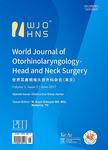A cross-sectional study on predictors of patients'' tinnitus severity
A cross-sectional study on predictors of patients' tinnitus severity作者机构:Department of Otorhinolaryngology Changzheng Hospital Naval Medical University (Second Military Medical University) Shanghai China
出 版 物:《世界耳鼻咽喉头颈外科杂志英文版》 (World Journal of Otorhinolaryngology - Head and Neck Surgery)
年 卷 期:2024年第10卷第03期
页 面:173-179页
学科分类:1002[医学-临床医学] 100213[医学-耳鼻咽喉科学] 10[医学]
基 金:National Natural Science Foundation of China(Grant/Award Numbers: 31900714, 81670905, 81870702, 82271136) Pyramid Talent Project of Shanghai Changzheng Hospital(Grant/Award Number: 0907) Innovative Clinical Research Projects of Shanghai Changzheng Hospital(Grant/Award Number: 2020YLCYJ-Y23)
主 题:hierarchical multiple linear regression tinnitus
摘 要:Objective: To identify factors that influence the severity of tinnitus via a hierarchical multiple linear regression ***: The study was a retrospective cross-sectional analysis. The study included 331 patients experiencing tinnitus as their primary concern, who visited Shanghai Changzheng Hospital of the Navy Medical University between 2019 and 2021. Data on general health status and disease characteristics were collected from all patients. With their consent, participants underwent audiological evaluatons and completed questionnaires to analyze the characteristics of their tinnitus and the factors influencing its ***: The correlation analysis showed a positive relationship between tinnitus frequency, tinnitus loudness, SAS scores, and PSQI scores with THI scores (P 0.05) among nine examined variables (gender, handedness, employment status, age, BMI, tinnitus frequency, tinnitus loudness, SAS scores, and PSQI scores). The variables that were extracted from the multiple regression were; for the constant;β =-51.797,t = -4.484,P 0.001, variable is significant; for the tinnitus loudness;β= 0.161,t = 2.604,P 0.05, variable is significant; for the tinnitus frequency;β = 0.000,t= 1.269,P= 0.206, variable is not significant; for the SAS scores;β= 1.310,t = 7.685,P 0.001, variable is significant; for the PSQI scores;β= 1.680,t = 5.433,P 0.001, variable is significant. Therefore, the most accurate model for predicting severity in tinnitus patients is a linear combination of the constant, tinnitus loudness, SAS scores, and PSQI scores,Y (Tinnitus severity) =β0+β1(Tinnitus loudness) + β2(SAS scores) +β3(PSQI scores).β0,β1,β2, andβ3 are -51.797, 0.161, 1.310 and 1.680, ***: Tinnitus severity is positively associated with loudness, anxiety levels, and sleep quality. To effectively manage tinnitus in patients, it is essential to promptly identify and address these accompanying factors and related symptoms.



